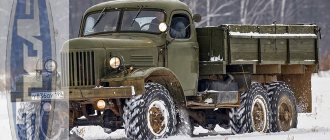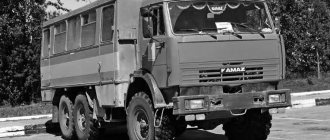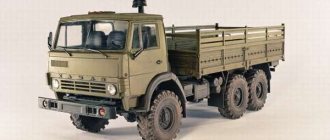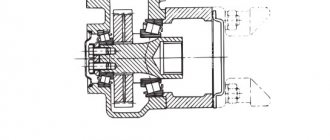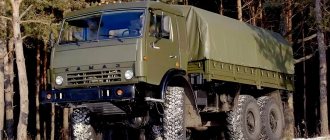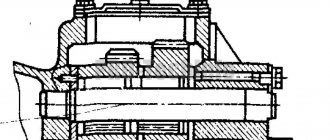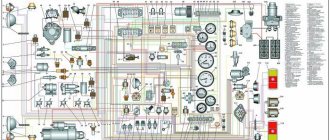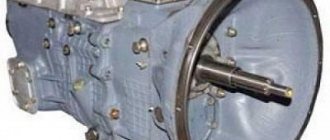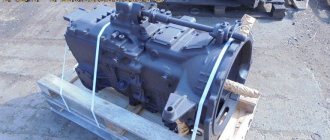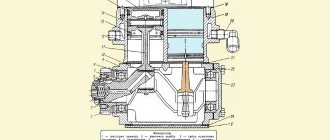Transfer cases (hereinafter referred to as RKP) are equipped with KAMAZ trucks used in off-road conditions. The range of equipment is large, so this unit also has different characteristics and applicability. The main mission of the transfer case is to distribute equal shares of torque from the engine between the axles of the car, connect the axles, lock the differential, and increase the vehicle's cross-country ability.
The vehicle moves in two modes:
- With low gear engaged off-road.
- With top gear engaged on general routes.
Contact 8-495-410-89-39 / [email protected]
The design of the manual transmission provides for differential locking of the front and rear drive axles, eliminating wheel slip when driving on a slippery surface.
Boxes used for off-road use have the ability to mechanically stop the outer axles of the car if necessary, for example, the front wheels are stuck in the snow, but the traction of the rear rollers is not affected. Disabling the front axle will help the truck escape from the trap using the rear wheels. The gearbox can be equipped with one or a group of low gear sets for use on difficult route sections, triggered by a mechanical or electronic type switch. Often this toggle switch is similar in design to the mechanism for turning on the 2WD or 4WD options. The car in low-speed gear mode moves slower, but with increased load from the engine to the wheels. Additional reduction gearboxes greatly increase the maneuverability and maneuverability of the vehicle when climbing, moving along dangerous roads, and can transmit part of the torque to other frame devices, such as a torsion winch. A car with all-wheel drive and a manual gearbox allows you to make maximum use of the advantages of equipment with all drive wheels. Let us highlight the main models.
Transfer case 43114
The automobile plant stopped equipping KAMAZ vehicles with all-wheel drive with transfer cases model 43114-1800020 on June 1, 2007. In order to increase the reliability and service life of the equipment, they are being replaced by more advanced ones with the permissibility of transferring a larger load to RCP brand 65111-1800020 with article number 43114-1800120. The company continues to produce spare parts for transfer cases model 43114-1800020. From this point on, the article starting with 43114 and ending with 120 indicates sample 65111.
The main components of the old-style transfer case 4310 (43114):
- Transfer case housing – 4310-1802012
- Crankcase cover - 4310-1802020
- Primary shaft assembly - 4310-1802024
- Intermediate shaft - 4310-1802084
- Differential - 4310-1802150
Main components of transfer case 43114-1800120 → see RCP 65111.
Transfer case problems
The RK on KamAZ helps vehicles overcome road obstacles and improves ride quality. Proper care of the transmission system on the driver's side can extend its life.
Each of the constituent parts of the Republic of Kazakhstan needs timely verification. Repairing differentials is considered expensive from a financial point of view. The main sign that a breakdown of this element has occurred is the appearance of a howling sound when moving at high speed. Motor vehicles are subject to mandatory diagnostics.
What is the cause of vibration? As a rule, this manifestation is a consequence of the fact that the fastening bolts have become loose. Also, it is worth inspecting the drive levers to see if the differential is worn out.
If it is difficult to switch on the speeds, you should check the condition of the rods. If the gear shift drive is deformed, the speeds will operate spontaneously.
If any of the above manifestations occur, disassembly of the transfer case is required. Worn clutch teeth and gears must be replaced. The troubleshooting procedure should be entrusted to specialists working in a specialized service center.
Transfer case 65111
The transfer case of this model complies with Euro 2-3 standards, is considered the most common mechanism, since it is used on KAMAZ vehicles models: 43114, 43118, 63501 8x8, 63501 8x8, 65111 (Euro 4), 43261 (Euro 1, 2), 4350 ( 4x4), 43501 (4x4), 43502, 5350 6x6, 53501 6x6, 53504 6x6, 6350 8x8. RKP 65111 is installed on all-terrain dump trucks produced by the Kama Automobile Plant, equipped with round flanges for attaching to the driveshaft. The manufacturer supplies the unit complete with or without a power take-off. The mechanism has no imported analogues and is therefore widely used throughout the CIS. Among the complete sets we can highlight: 65111-1800020-10 (without PTO), 65111-1800020 (with PTO).
Main characteristics:
- dimensions - 0.5*0.52*0.51 m;
- weight – 257 kg;
- maximum torque – 700 Nm;
- low gear ratio – 1.692;
- overdrive gear ratio – 0.917;
- the nature of the differential is planetary, asymmetrical type;
- lubricant brand (recommended) - TSP-15K;
- lubricant volume – 6 l;
- Replacement frequency is annually.
Transfer case specifications
| Designation | 65111-1800020 | 65111-1800020-10 |
| Weight, kg: | 257 | 250 |
| Maximum permissible input torque on the input shaft, Nm: | 10000 | |
| First (low) gear ratio: | 1,662 | |
| Gear ratio of the second (highest) gear: | 0,917 | |
| Center differential: | Planetary with cylindrical wheels is asymmetrical, distributes the power flow in proportion: to the rear axles - 66.7%, to the front axle - 33.3%. | |
| Possible power take-off: | ||
| — from the top hatch of the transfer case: | 44.12 kW (60 hp) | 44.12 kW (60 hp) |
| — from the rear end, from the winch PTO drive: | 44.12 kW (60 hp) | |
| Gear shift control: | Remote, pneumatically driven by a three-position cam pneumatic valve | |
| Differential locking mechanism control: | Remote, pneumatically driven by a two-position pneumatic crane | |
| Control of turning on the winch drive power take-off: | Electro-pneumatic, electric switch, electro-pneumatic valve | |
| Lubrication system: | Combined, all parts are splash lubricated, low gear bearings on the intermediate shaft are additionally lubricated from a tray on the crankcase | |
Main components:
- Transfer case housing – 65111-1802012
- Crankcase cover - 65111-1802020-10
- Primary shaft assembly - 65111-1802024
- Intermediate shaft - 65111-1802084-10
- Differential - 65111-1802150-10
Technical features of KamAZ-4310
KamAZ 4310
The machine has several modifications that differ in power, the presence/absence of a winch, and a berth. The peculiarity of the basic version is that it includes a platform with a voluminous awning and a rear, folding side. More than 25 people can fit in the back of this vehicle. The cabin provides comfort and convenience to the driver when moving.
The vehicle dimensions are as follows: 7650×3590×2500 mm. Moreover, the weight exceeds 8 tons. Acceleration to 60 km/h occurs in approximately 35 seconds. However, about 30 liters of fuel are consumed per 100 km.
Transfer case 6522
This transfer case model is a domestic analogue of the imported ZF 2000 and ZQC 2000-69A units. RKP 6522 is installed on dump trucks, truck tractors, and other modifications of popular Russian trucks based on the chassis of the same name with other superstructures, and is equipped with round flanges for the cardan. The plant supplies the transfer case model 6522 complete with or without a power take-off.
Main characteristics:
- dimensions - 0.5*0.52*0.51 m;
- weight – 385 kg;
- the nature of the differential is planetary type;
- lubricant brand (recommended) - TSP-15K;
- lubricant volume – 6.2 l;
- Replacement frequency is annually.
Main components:
- Transfer case housing – 6522-1802010
- Primary shaft assembly - 6522-1802024
- Intermediate shaft - 6522-1802083
- Differential - 6522-1802150
Design and principle of operation
The transfer case, being an important component of the chassis, redirects the force by shifting to a lower or higher gear created by the motor between the axles of a KAMAZ truck, significantly increasing the truck’s cross-country ability. The car will easily overcome off-road conditions with a lowering differential, and will feel great on a flat track after upshifting.
Trucks from the Kama Automobile Plant are equipped with a differential with four satellites and a sun gear connected to the rear axle drive shaft. The torque generated by the machine's power unit is directed through the sun gear to the drive shaft of the front bogie. When the differential is engaged (the mechanism is unlocked), it maintains constant and continuous traction on all axles, preventing excessive overload in the operation of the elements of the chassis system of the KAMAZ vehicle. The described device can be turned off (locked) if necessary. In this case, all the axles of the car will rotate as one unit without uniform distribution of force.
Actuating the transfer case using the necessary toggle switches sends the diaphragm to its original position, since compressed air no longer enters the pneumatic chambers. At the same time, the torque is evenly distributed to the races and satellites (components of the center differential). When driving on a good road, they rotate around the main axis. But as soon as the quality of the road surface deteriorates, rotation also occurs around its own axes. As a result, this technical feature helps in optimal load differentiation between the truck axles.
The transfer case differential, when in the on state, completely removes the load from the gearbox, extending the life of the gearbox components and mechanisms. Its blocking is removed only when the vehicle is moving through terrain saturated with elements (mud, ice, snow) that impede the smooth movement of the vehicle and pose a threat to the safety of driving the vehicle.
The design of the transfer case requires the following elements:
- Cast iron crankcase.
- Main or drive shaft.
- Intermediate or secondary shaft.
- Front axle shaft.
- Rear axle shaft.
- PTO.
- MAUD.
- Central control drive.
- Gear wheel that engages overdrive.
Signs of trouble
Such manifestations, which may indicate a defect in the manual transmission, will serve as a guide to an immediate visit to an auto repair shop:
- strange rattling, knocking, howling in the area of the transfer case housing, indicating possible damage to the gear teeth associated with failure of the bearings of one of the shafts;
- random gear shifting, indicating wear or defects in the teeth of couplings, gears, including carriages. The shift fork foot may be damaged;
- difficulties with shifting gears that arose due to the deterioration of parts that form the transfer case design;
- external visually noticeable cracks and chips of the crankcase, broken fasteners.
Step-by-step method for dismantling the transfer case:
- Draining the lubricant from the gearbox crankcase through the technological hole by unscrewing a special plug.
- Removing the protective screens placed on the floor of the platform by first unscrewing the lock nut.
- Disconnecting the transfer case from the driveshaft.
- Disconnecting the manual transmission from the front axle drive cardan.
- Disconnecting the transfer case from the drive shaft of the intermediate axle drive.
- Disconnecting the manual gearbox from the drive shaft of the power take-off drive.
- Disconnecting the power speedometer converter plug.
- Disconnecting the wires of the control illumination, signaling the state of upshift, downshift and MOD.
- Disconnecting the ground wire from the bracket.
- Disconnecting the hoses connecting the MOD pneumatic chambers and all shafts.
- Unscrew the clamp nuts and remove the transfer case.
Step-by-step guide for installing RCP:
- A previously dismantled or new transfer case is moved under the bottom of the truck using a special trolley. The holes of the mounting flange and the cardan are aligned, the bolts are inserted, and the nuts are tightened.
- Air hoses used to feed the pneumatic chambers of the differential, axles, and power take-off are mounted in place.
- The transfer case mass is screwed to the bracket.
- The wires of the control illumination, signaling the state of upshift, downshift and MOD, are connected to their terminals.
- Speedometer installation.
- Combining the manual gearbox with the power take-off cardan drive.
- Combining the transfer case with the drive shaft of the intermediate axle drive.
- Combining the manual gearbox with the front axle drive cardan.
- Integrating the transfer case with the main driveshaft.
- Installation of protective screens.
- Filling the crankcase with new oil of a certain brand. The grease level is normal if it touches the bottom edge of the filler hole.
How to reassemble
The assembly process is carried out in the reverse order of the dismantling described above:
- The transfer case returns to the installation area and is raised by the lift to its previous height.
- Align the holes of the RC and the supporting structure to screw the bolts and nuts back into place.
- Pneumatic hoses are attached.
- The ground wire and control lighting wires are connected.
- Speedometer plug, driveshafts are attached.
Please note that when installing cardan shafts, it is necessary to tighten the self-locking nuts to the required torque values according to the instructions; for this you need to use special torque wrenches. When the transfer case is installed, oil is poured back into the housing through the hole. The oil level must correspond to the position of the lower control plug.
